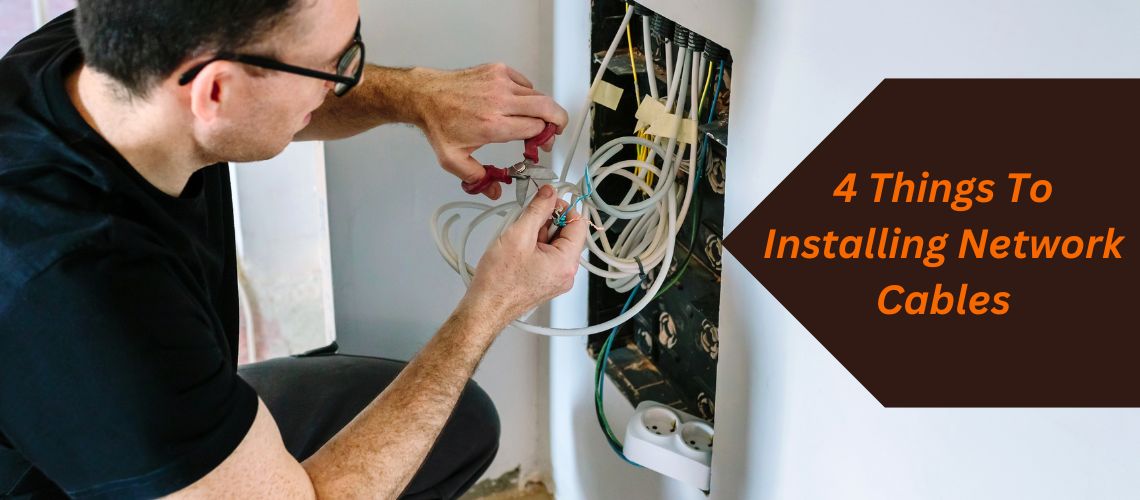
Request A Quote Today!
"*" indicates required fields

Network cables are the backbone of any wired network infrastructure, essential for ensuring reliable and high-speed data transmission. Whether in a corporate setting or a home office, the meticulous installation of network cables, such as Ethernet cables, is critical. The ethernet wiring installation involves not just plugging in cables but adhering to specific best practices that enhance performance, safety, and organization. In this blog, we will delve into four key areas to focus on during network cabling install: the importance of cable management, best practices for cable organization, utilizing cable management tools, and troubleshooting common cable issues. By following these guidelines, you can ensure a robust and efficient network infrastructure.
The Importance of Cable Management
Improves Airflow and Cooling in Electronic Devices
Proper cable management is pivotal in maintaining optimal airflow and cooling within electronic devices and network environments. Tangled or improperly routed cables can obstruct airflow, leading to overheating devices such as routers, switches, and servers. Efficient cable management practices ensure that wires are neatly organized, allowing air to circulate freely and cooling systems to function effectively. This not only extends the lifespan of your equipment but also prevents unexpected shutdowns or damage due to overheating.
Reduces Safety Hazards and Fire Risks
Poorly managed cables can create significant safety hazards. Overlapping and entangled wires can lead to electrical short circuits, increasing the risk of fires. Additionally, exposed or damaged cables pose a tripping hazard, which can result in physical injuries in the workplace or home environment. By following meticulous cable management techniques during ethernet cable installation, you can mitigate these risks, ensuring a safer environment for everyone.
Enhances Aesthetics and Organization in Workspaces
A clutter-free workspace not only looks professional but also enhances productivity. When cables are well-organized and concealed, it eliminates the visual clutter that can be distracting and unappealing. Proper ethernet cable installation management techniques help maintain a tidy workspace, making identifying and managing individual cables easier when troubleshooting or modifying the network. This level of organization also facilitates easier cleaning and maintenance of the workspace.
Best Practices for Cable Organization
Decluttering Cables
The first step in effective cable management is decluttering. Start by removing unnecessary cables and organizing the essential ones. Group similar cables together and use color-coded cable ties or labels to differentiate between them. This practice simplifies future maintenance and makes it easier to identify cables during troubleshooting.
Cable Labeling
Labeling cables is a critical practice that ensures you can quickly identify each cable’s purpose and destination. Use durable labels that can withstand the test of time and environmental conditions. Label both ends of each cable to make it easier to trace connections. This is particularly important in complex network setups where numerous cables are used, as it prevents confusion and reduces the time spent on network modifications or repairs.
Cable Routing Techniques
Efficient cable routing techniques involve planning the pathway cables follow to minimize interference and ensure neatness. Use cable trays, conduits, or raceways to route cables along walls or ceilings. Avoid running cables parallel to power lines to prevent electromagnetic interference. Additionally, ensure wires have a gentle bend radius to avoid kinks or breaks, which can degrade performance.
Concealing Cables
Concealing cables improves the aesthetics of a workspace and protects them from damage. To hide cables, use cable sleeves, raceways, or under-desk cable management solutions. Consider installing cable conduits within walls or floors for a more permanent solution. Concealed cables are less likely to be accidentally unplugged or damaged, ensuring a more reliable network setup.
Maintenance and Upkeep
Regular maintenance and upkeep of your network cables are essential to ensure long-term performance and reliability. Periodically inspect cables for signs of wear and tear, such as fraying or damage to the insulation. Replace any damaged cables promptly to prevent network disruptions. Ensure cables remain securely fastened and organized to avoid tangling or accidental disconnections.
Utilizing Cable Management Tools
Cable Trays
Cable trays are indispensable tools for managing large bundles of cables. They provide a structured pathway for wires, keeping them organized and preventing them from sagging or tangling. Cable trays can be mounted on walls, ceilings, or under desks, offering cable routing and management flexibility. They are instrumental in environments with extensive cabling needs, such as data centers or large office buildings.
The use of cable trays also facilitates more manageable maintenance and troubleshooting. When cables are neatly arranged in trays, tracing and identifying specific connections is simpler. This organized approach not only enhances network management efficiency but also improves overall safety by reducing the risk of cables becoming damaged or causing accidents. Investing in high-quality cable trays can significantly enhance the longevity and reliability of your network infrastructure.
Cable Ties and Clips
Cable ties and clips are simple yet highly effective tools for bundling and securing cables. Reusable cable ties are beneficial as they allow for adjustments and reconfigurations without cutting and replacing ties. They come in various sizes and colors, enabling easy organization and identification of different cable types.
Cable clips can be attached to various surfaces, guiding cables along specific routes and preventing them from becoming tangled or creating clutter. These clips are ideal for securing cables along walls, desks, or other surfaces, keeping them neatly arranged and out of the way. Using cable ties and clips, you can maintain a tidy and organized workspace, reduce the risk of cable damage, and ensure that your network remains efficient and reliable.
Cable Sleeves and Raceways
Cable sleeves and raceways are essential for concealing and protecting cables. Sleeves can bundle multiple wires together, providing a neat and organized appearance while shielding the cables from physical damage. They are available in various materials and sizes, catering to different cabling needs and environments.
Raceways offer a more rigid and secure option for cable management. These enclosures can be mounted on walls or ceilings, keeping cables hidden and protected from potential damage. Raceways are particularly useful in high-traffic areas where cables might be exposed to physical stress or accidental disconnections. By using cable sleeves and raceways, you can enhance the aesthetics of your workspace, protect your cables, and ensure a safer and more efficient network setup.
Troubleshooting Common Cable Issues
Cable troubles are frequently the root cause of network issues. Damaged cables, faulty cable types, and loose connections are common problems. Ensure cables operate correctly by giving them a routine inspection and test. Use a cable tester to find cable breakage or problems. To prevent performance deterioration, ensure the new cables you install meet your network’s type and category criteria.
Future-Proofing Your Network with Cabling Drops
Network future-proofing from Cabling Drops entails planning for scalability and technological advancements. To further ensure your network is ready for future demands, consider incorporating network cabling services into your plans. Even if your current equipment only requires Cat5e, you should still use higher-category cables, like Cat6 or Cat6a, when installing network lines. As your network demands increase, this enables improved performance and higher data rates. To avoid requiring significant rewiring in the future, schedule additional cabling drops in key places to support additional devices or reconfigurations.
Frequently Asked Questions
Why is it important to follow specific guidelines when installing network cables?
Following specific guidelines during ethernet wiring installation is crucial to ensure optimal network performance, safety, and longevity. Proper installation techniques prevent issues such as signal interference, data loss, and physical damage to cables, which can lead to network downtime and costly repairs.
How does proper cable management impact the performance of a network?
Proper cable management impacts network performance by preventing signal interference, reducing the risk of physical damage to cables, and maintaining organized and accessible connections. Well-managed cables ensure data transmission remains reliable and efficient, minimizing network disruptions.
What are the best practices for ensuring the correct cable type is installed?
- To ensure the correct cable type is installed, follow these best practices:
- Identify the specific requirements of your network, including data rate and distance.
- Choose cables that meet or exceed these requirements, such as Cat6 for gigabit networks.
- Label and document the cable types and their locations for future reference.
- Adhere to industry standards and guidelines for cable installation and testing.
Why is adhering to industry standards and regulations crucial in network cable installation?
Adhering to industry standards and regulations ensures that network cable installations are safe, reliable, and capable of supporting current and future technologies. Compliance with standards like TIA/EIA and IEEE helps prevent issues related to signal integrity, electrical interference, and safety hazards.
How can maintaining appropriate cable lengths and minimizing bends affect network efficiency?
Maintaining appropriate cable lengths and minimizing bends is essential for preserving signal quality and preventing physical damage. Excessively long cables can cause signal attenuation, while sharp bends can damage the cable’s internal structure, leading to data loss and reduced performance. Proper cable management practices ensure cables are the correct length and follow a smooth, gentle path.